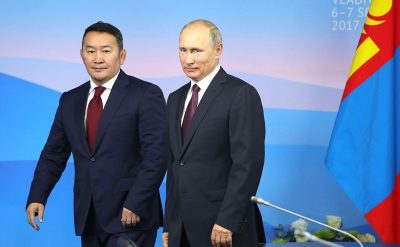The Russia-Mongolia Strategic Partnership
Mongolia Serves as a Lesson in Geo-political Management for the West

On September 2nd, Russian President Vladimir Putin began a 2-day visit to the Mongolian capital Ulaanbaatar, at the conclusion of which a permanent treaty of mutual friendship and extensive strategic partnership will be signed with Mongolian President Khaltmaagiin Battulga. This new treaty contains a particular focus on infrastructural cooperation, but also includes economic and scientific aspects. In a parallel development, the East Asia Railroad Community initiative will include North Korea, South Korea, China, Japan, Russia and Mongolia, and there are hopes that it might also develop into a strategic partnership encompassing trade, energy-cooperation and some security-cooperation.
Undoubtedly, the personal affinity between Presidents Putin and Battulga, enhanced by their achievements as elite judokas, has smoothed the path to this treaty. However, in order to understand Mongolia’s developmental trajectory and its mutually beneficial relations with both Russia and China, we need to look beyond interpersonal considerations.
First let’s look at the historical, geographical, demographic and economic fundamentals.
Mongolia has the world’s 18th largest surface-area but only the world’s 134th largest population. It has the lowest population-density of any sovereign nation-state on Earth. However, Mongolia also has extremely impressive mineral-deposits, with copper, gold and coal the most notable among them. Minerals account for 80% of all Mongolian exports, with livestock accounting for most of the rest.
Put those facts together, and prima facie we might initially be justified in imagining that Mongolians were perpetually prone to geo-strategic anxiety. However, there seems to be very little evidence that this is actually the case. Mongolia serves as an exemplary case of pragmatic, non-conflictual geo-political management on the part of its own leadership, and also on the part of both the Russian Federation and the People’s Republic of China. The depth and complexity of the interconnections between the developmental trajectories of Russia, Mongolia and China as distinct but cross-pollinating civilizations, and the interconnections between their ancestral populations, lie far beyond the scope of this article, so I will limit my discussion of the historical background, beginning with the immediate post-war period.
Upon the foundation of the People’s Republic of China in 1949, a treaty of mutual recognition was signed with Mongolia, and the PRC agreed to recognize Mongolia’s admission to the United Nations, finally settling the sovereignty issue once and for all, in 1961. Cooperation between the Soviet Union and Mongolia was extensive. In an interview with the Mongolian newspaper Odriyn Sonin published on September 1st, President Putin drew attention to the joint Russian-Mongolian victory over the Japanese in the battles of Khalkhin Gol in 1939, which delayed Japan’s entry into the second world war, and thereby made more Red Army units available for the Battle of Moscow. President Putin also made a point of noting Russia’s debt of gratitude to the Mongolian people, who sent aid to the Red Army during the Great Patriotic War. This aid included sending horses to Soviet cavalry-units and warm clothes for Red Army soldiers.
However, with that heart-warming history cursorily laid out, it still hardly requires explanation that, given Mongolia’s geography, demographics and natural resources, the maintenance of a stable and secure Mongolia will always require pragmatic, non-conflictual geo-political management by Mongolia’s own political leadership, and by the political leaderships of the Russian Federation and the PRC.
The good news is that this is actually happening.
All parties concerned recognize that the world needs buffers.
Isn’t there a lesson in here for the architects of the Ukrainian catastrophe?
Regarding Ukraine, I’ve lost count of the number of times I’ve heard people argue that
“President Kuchma (or Yanukovych) made the mistake of trying to sit on two stools….”
I have always been bemused by this argument – in the cases of both Kuchma and Yanukovych, “sitting on two stools” was the only pragmatic or viable policy. As long as Russia could have secured protections against its markets being flooded through entrepôt-trade and against the prospect of NATO advancing to its borders, and as long as the EU didn’t get greedy for yet another colony, then the policy of “sitting on two stools” would have been the optimal policy for the maintenance of a secure, stable and prosperous Ukraine.
Unfortunately, the EU leadership just wasn’t prepared to make those kinds of pragmatic compromises. The Eurasian Customs Union offered Ukraine $15 billion in aid with no strings attached, immediate quota-free access to all of its markets, and equal partner status. The EU wasn’t prepared to match that offer – they just wanted an agricultural colony with some “human rights” lullabies mixed in to pacify the gullible natives (a bit like the British persuading Aboriginal Australians to relinquish any claim to their ancestral lands in exchange for bags of coloured glass beads).
The Aboriginals had never seen glass before, let alone shiny coloured glass. They reasoned that it must have been very valuable.
Anyway, back to Ukraine, as soon as the Eurasian Customs Union offered Ukraine a better trade-deal than the EU was prepared to offer, it immediately triggered a pro-western coup d’etat.
In contradistinction, isn’t Mongolia a refreshing example of geo-political pragmatism?
President Battulga understands that his nation’s sovereignty is best maintained through a balanced trade-policy and FDI-policy. Furthermore, he is absolutely committed to the principle, which is enshrined in Mongolia’s constitution, that Mongolia’s natural resources belong to Mongolia’s people, and should be used for their benefit. What we see in Mongolia is a model of sovereignism which is premised on multilateral, mutually respectful recognition of Mongolia’s status as a natural buffer.
*
Note to readers: please click the share buttons above or below. Forward this article to your email lists. Crosspost on your blog site, internet forums. etc.
Featured image is from en.kremlin.ru

